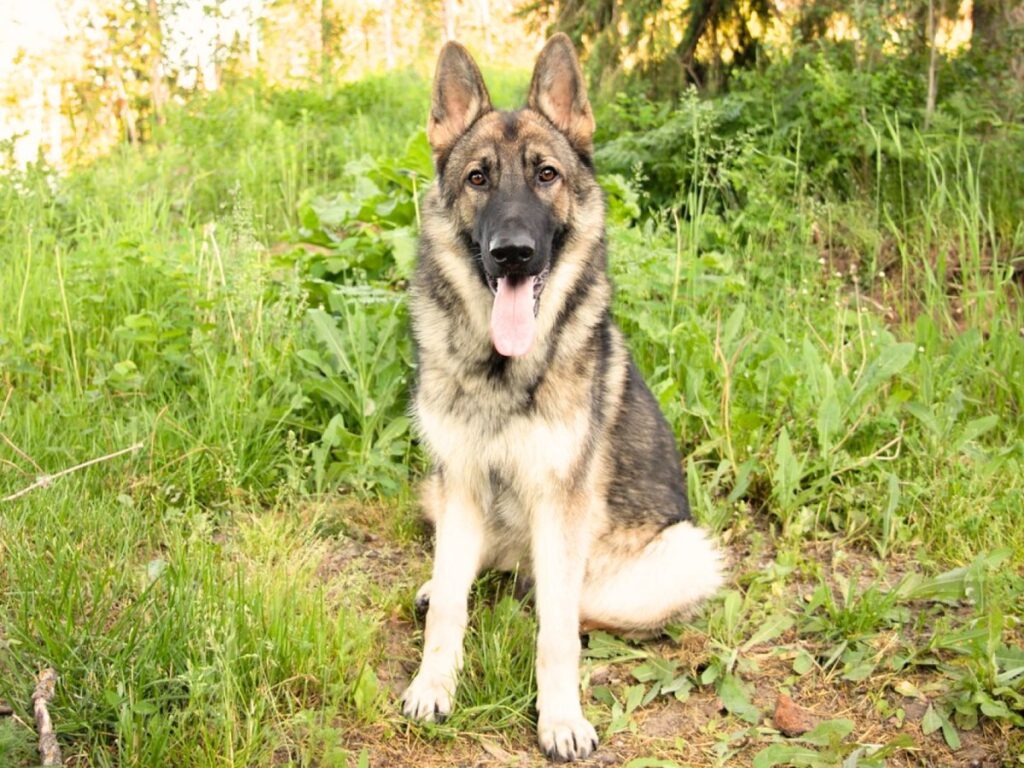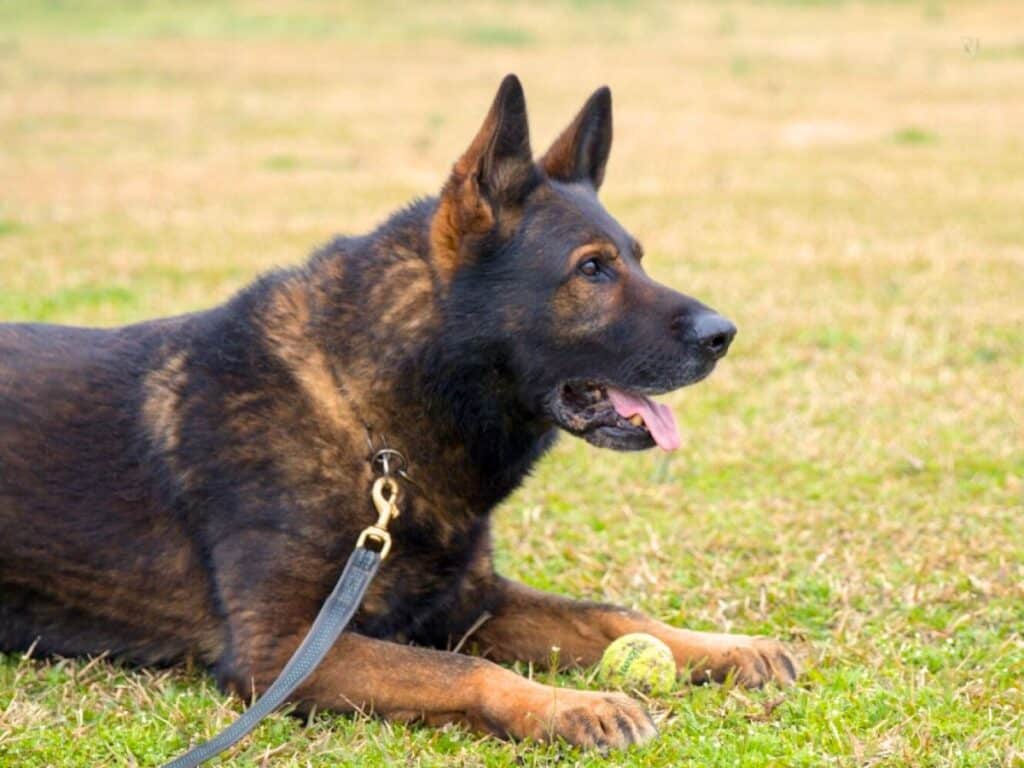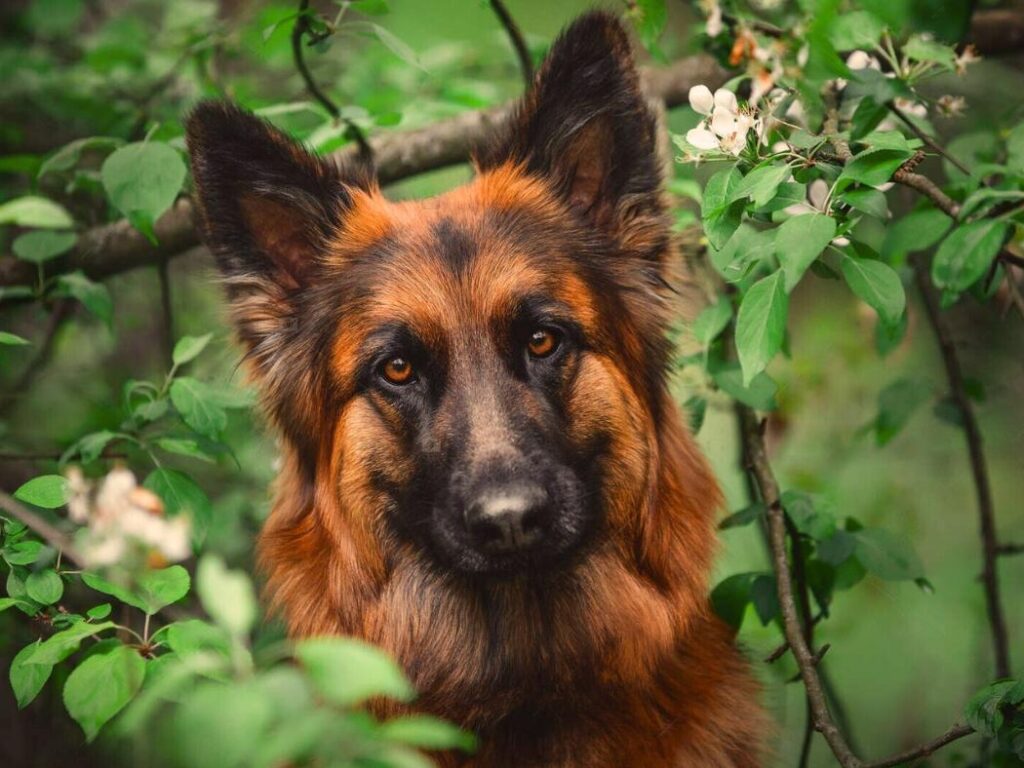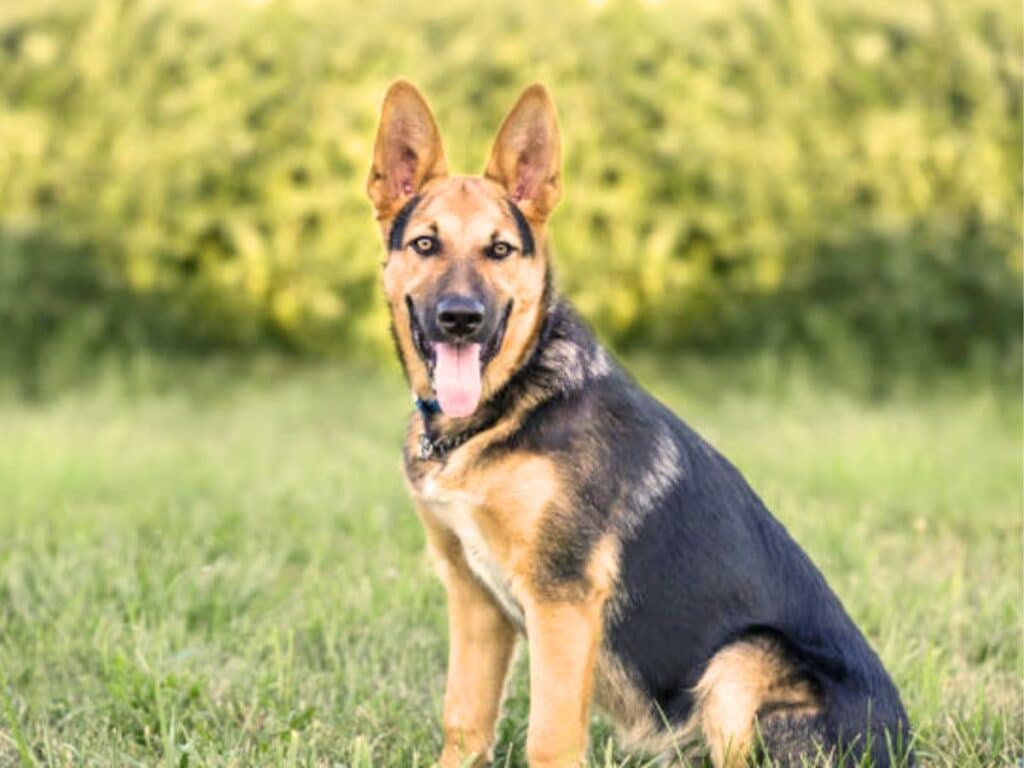The American Tundra Shepherd Dog, also known as the ATS, is a unique breed that was developed in the late 1960s by Frank Catania.
This breed is a result of the crossbreeding between the German Shepherd and the Alaskan Tundra Wolf.
The ATS has gained a reputation as one of the best working dogs in the United States. One of the reasons for this is their impressive build and size, which commands respect and attention.
Click here to learn more about the German Shepherd dog breed.
American Tundra Shepherd Dog Overview
Breed Popularity
It is considered a rare breed in terms of popularity. However, their exceptional skills, intelligence, and versatility are gaining more recognition among dog enthusiasts and breeders.
Average Height of an Adult ATS
This is a large breed with males typically standing between 27 and 33 inches tall at the shoulder, while females are slightly shorter, typically measuring between 24 and 27 inches.
Average Weight
As for weight, males are heavier and can weigh anywhere between 100 to 140 pounds, while females weigh between 85 to 100 pounds.
Life Expectancy
With proper care, these dogs have an average lifespan of 13 to 15 years, which is similar to that of other large dog breeds.
RELATED: How Long Do German Shepherds Live?
Group
This breed of German shepherd belongs to the Working Group of dogs, which means they were bred to perform specific tasks such as herding, guarding, or assisting their human counterparts in various fields.
This breed is known for their stamina, strength, and courage, making them ideal for jobs that require physical exertion.
Physical Features of the American Tundra Shepherd
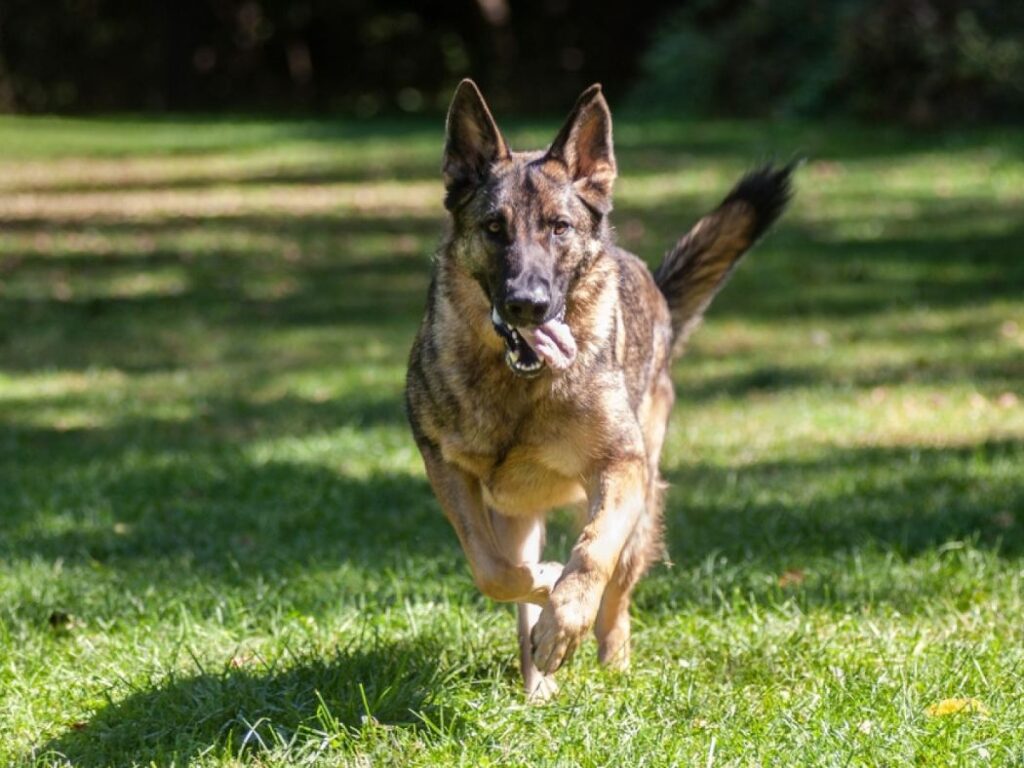
The ATS is an impressive breed with striking physical features that make them stand out from other breeds.
They are a large dog breed with a well-proportioned body that gives them a powerful and imposing presence.
Head
The head is large but in proportion to the size of the dog’s body, giving the dog a striking and distinctive appearance.
Mouth
The dog’s mouth should ideally have a scissor bite. A level bite is also okay, though.
Eyes
This variety of GSDs can have a range of eye colors, including hazel, yellow, black, brown, or even orange.
Nose
The nose is large, black, and has well-defined nostrils, allowing for efficient air intake and powerful scenting ability.
Ears
The ears are l like most GSDs, large, and their size is in proportion to the rest of the head. They are generally standing upwards, or they may also be slightly angled.
Chest
The chest needs to be robust and powerful, and it should go all the way down to the elbows or potentially even lower than that.
Back
The back of the dog is strong and level, and it is significantly longer in relation to the dog’s height. Strong hips and thighs provide the foundation for this structure. The croup has a very small tilt in the direction of the tail.
Legs
The dog’s legs are robust, well-developed, and of a size that befits its size. There is no difference in length between the front and back legs.
Hocks
Hocks should be long and well-angled, providing a strong foundation for the dog’s athleticism. This conformation allows the dog to move with ease and speed over a variety of terrains while maintaining excellent balance and stability.
Gait
The dog walks in a steady and solid manner, maintaining a balanced and extended reach throughout its gait.
Tail
The tip of the tail is rounded, fluffy, and curved in a manner that is reminiscent of a sabre.
It reaches beyond the hock, yet it does not make contact with the ground. It does not come together to make a complete curl that spans the back.
Coat
The dog’s coat can be short, medium or long.
Color
- Black and silver color.Black and Brindle color. Black with off-white/cream markings.
- Black grey steel having tan markings
- White brown and black brindle with silver markings.
- Black and Tan Sable Silver with White markings.
Check out this video of American Tundra Shepherds in action…
Temperament

This is a breed with an exceptional temperament, combining intelligence, loyalty, and cautiousness towards strangers.
Their alertness allows them to detect any unusual activity, and their remarkable memory retention and ability to learn commands make them ideal for service jobs like law enforcement and search and rescue.
This breed is deeply devoted and loyal to their owners, valuing human companionship and family time.
They possess outstanding scenting abilities that make them exceptional at tracking and air scenting, which is why they excel in search and rescue operations.
This breed of German shepherd has a natural hunting instinct and can be an excellent hunting companion with proper training and exercise.
However, they require lots of physical and mental stimulation to stay happy and healthy.
Their cautious nature towards strangers makes them reserved and protective of their family and property, but early socialization and training can help them become more confident and less suspicious of new people and situations.
History Of The American Tundra Shepherd Dog:
The American Tundra Shepherd Dog has an interesting and inspiring origin story.
This rare breed was developed in the late 1960s by Frank Catania, a U.S. Army veteran who served in the K-9 Corps division.
The idea for the breed began with the “ATS Project,” a government-funded program that aimed to create a new breed of working dog by crossing German Shepherds with Alaskan Tundra Wolves.
The ATS Project started in 1968, and it quickly gained support and funding from the U.S. government.
However, after the Vietnam War ended, the government withdrew their funding for the program, leaving the project in limbo.
Despite this setback, Frank Catania was determined to see the project through to completion.
He made a commitment to continue developing the ATS, even if it meant doing it on his own.
Frank Catania relocated to Edwardsville, Kansas, where he set up his own personal Midwest K-9 Training Estates facility.
There, he continued to breed and train the ATS, honing its skills and perfecting its temperament.
His hard work and dedication paid off, and the American Tundra Shepherd Dog quickly became recognized as a highly capable working dog.
Frank Catania
Frank devoted over forty years to breeding and training dogs. He trained professionals in the canine world such as breeders, dog handlers, and show judges.
Frank’s kennel rescued, trained, and registered American Tundra Shepherd Dogs. Despite becoming quadriplegic in 1973 after being thrown off a horse, Frank continued to teach and train others.
He even ran a dog training school recognized by the Kansas Department of Education.
Frank passed away in 2008, but his legacy lives on through the American Tundra Shepherd Foundation.
The foundation is dedicated to continuing Frank’s work through breeding and development programs.
American Tundra Shepherd Foundation
The American Tundra Shepherd Foundation is a non-profit organization founded by Frank Catania.
The foundation is dedicated to the preservation and promotion of the ATS breed.
The foundation was established to support responsible breeding practices and ensure the health and well-being of this remarkable breed.
One of the primary objectives of the ATS Foundation is to support research and education related to the breed.
They fund studies to better understand the breed’s genetics, temperament, and health issues.
The information gleaned from these studies is used to develop best practices for breeding and raising American Tundra Shepherd Dogs, ensuring their long-term sustainability.
In addition to supporting research and education, the ATS Foundation provides resources and support for ATS dog owners.
They offer training and socialization programs that help ensure that American Tundra Shepherd Dogs are well-behaved and socialized with people and other animals.
They also provide advice and guidance on the care and feeding of American Tundra Shepherd Dogs.
Moreover, the Foundation advocates for the use of ATS Dogs in various fields, such as search and rescue and law enforcement.
They believe that the breed’s intelligence, loyalty, and protective nature make them ideal working dogs in these areas.
Major Faults in the American Tundra Shepherd Dog
- The American Tundra Shepherd Dog has a temperament that is best described as very submissive.
- The breed may have an overshot or undershot jaw, with the lower or upper teeth being noticeably out of alignment with the opposite jaw.
- The ATS is expected to have a full set of 42 teeth, but sometimes they may have fewer than 39 teeth, which is below the breed standard.
- The ATS comes in twelve acceptable colors according to the Global Kennel Club, with solid color preferred on the back and white markings limited to an inch in diameter on the chest. It is important to note that any other white markings are not permissible.
- In some cases, one testicle may be lower than the other, but this is not necessarily a cause for concern. It can take up to one year for the second testicle to fully drop in a maturing male dog.
Other Faults
- When searching for an American Tundra Shepherd, be aware of albino traits, such as white fur, pink nose, and pink eyes.
- Pay attention to the length of the tail, which should not be too short or too long, and ensure that the ears are not bent, folded, drooping, or floppy.
- Check for splayfeet or cat feet, and make sure the body is not too short or too long.
- The teeth should not be discolored.
- The dog’s back should not be roached, swaybacked, or too narrow.
- Also, watch out for a croup that drops significantly from the hips to the base of the dog’s tail.
Exercising An American Tundra Shepherd Dog
The American Tundra Shepherd is a moderate-energy breed that requires regular exercise to maintain its physical and mental health.
This breed was originally bred for endurance and work, so providing opportunities for exercise and activity is important to keep them happy and healthy.
A daily walk or jog for at least 30 minutes is recommended, but this breed can benefit from additional exercise such as running, hiking, or swimming.
Activities that stimulate the mind, such as agility training or interactive play sessions, can also be beneficial for this intelligent and active breed.
Feeding
These dogs are large and active, so they require a high-quality diet that is rich in nutrients to support their energy needs.
It is recommended to feed an American Tundra Shepherd Dog a diet that is high in protein and fat, as these nutrients are important for building and maintaining muscle mass and providing energy for the dog’s active lifestyle.
However, it is important to ensure that the dog does not become overweight, as this can lead to a range of health problems.
When selecting dog food for an American Tundra Shepherd Dog, it is important to choose a high-quality, premium brand that is formulated specifically for large breed dogs.
It is also important to follow the recommended serving sizes based on the dog’s weight and activity level, and to avoid overfeeding or feeding too many treats.
Training
These dogs are intelligent and eager to please, making them highly trainable with the right approach and consistency.
When training an ATS, it is important to start with basic obedience commands such as sit, stay, come, and heel.
Positive reinforcement techniques, such as praise and treats, can be effective in motivating the dog to learn and obey commands.
However, it is important to avoid using punishment or physical force, as this can lead to fear and aggression in the dog.
Care Tips
The American Tundra Shepherd Dog has a dense, thick coat that requires regular grooming to keep it in good condition.
Proper grooming not only keeps the coat looking healthy and shiny but also helps to prevent skin irritation and matting.
This breed sheds heavily twice a year during seasonal changes, so it is important to brush their coat once a week to remove loose hair and prevent matting.
Using a slicker brush and metal comb can be effective for removing tangles and preventing mats.
Bathing should be done as needed, typically every 6-8 weeks, using a mild shampoo formulated for dogs.
Overbathing can strip the coat of its natural oils, leading to dry skin and coat.
In addition to regular brushing and bathing, it is important to check the ears, teeth, and nails of the American Tundra Shepherd Dog.
Socialization
Socialization is also an important part of training for an American Tundra Shepherd Dog.
These dogs can be protective and wary of strangers, so it is important to expose them to a variety of people, animals, and situations from a young age to help them develop good social skills and confidence.
In addition to basic obedience and socialization, ATS may benefit from more advanced training and activities, such as agility, tracking, and obedience competitions.
These dogs are highly active and enjoy working with their owners, so providing them with mental and physical stimulation can help to prevent behavior problems and keep them happy and healthy.
Common Health Concerns
As with any breed, the American Tundra Shepherd Dog may be susceptible to certain health issues.
While this breed is generally considered to be healthy, it is still important to be aware of potential health concerns to ensure that the dog receives proper care and treatment.
Some of the common health issues that ATS may be prone to include bloat, a potentially life-threatening condition where the stomach twists and fills with gas.
- Cardiomyopathy, a heart condition that can lead to heart failure.
- Cataracts, a clouding of the eye that can cause vision loss.
- Degenerative myelopathy, a progressive disease that affects the spinal cord and can lead to paralysis.
- Ear infections, which can cause discomfort and pain.
- Elbow dysplasia and hip dysplasia, joint disorders that can cause pain and difficulty moving.
- Entropion, an eye condition where the eyelid turns inward and causes irritation.
- Epilepsy, a neurological disorder that can cause seizures.
- Heart disease, a range of conditions that affect the heart.
- Hypertrophic osteodystrophy, a painful bone disease that affects young dogs.
- Vision problems, including cataracts and other eye disorders.
Conclusion
In conclusion, the American Tundra Shepherd is a unique and fascinating breed that is still relatively unknown to many people. This dog has a rich history and is prized for its loyalty, intelligence, and working abilities.
While there is still much to learn about the health, temperament, and behavior of this variety of German Shepherd, what we do know paints a picture of a dog that is highly trainable, active, and loving.
With the right training, socialization, and care, this breed can make an excellent companion for the right owner.
Frequently Asked Questions (FAQs)
What is the American Tundra Shepherd?
The American Tundra Shepherd is a rare breed of dog that developed in the late 1960s by crossing German Shepherds with Alaskan Tundra Wolves. They were originally developed for the U.S. Army’s K-9 Corps division as a new breed of working dog. They are known for their high intelligence, loyalty, and protective nature.
Are American Tundra Shepherds Good Family Dogs?
Yes, American Tundra Shepherds can make great family dogs. They are known for being loyal, affectionate, and protective of their family members. However, they require proper socialization and training from an early age to ensure they develop good behavior around children and other pets.
How Much Does An American Tundra Shepherd Dog Cost?
The cost of an American Tundra Shepherd Dog can vary depending on the breeder, location, and the dog’s pedigree. On average, they can cost anywhere from $1,500 to $3,000. It’s important to do your research and find a reputable breeder who health tests their dogs and ensures proper socialization and early training.
What are some common health issues that affect the breed?
Like all dog breeds, American Tundra Shepherds are susceptible to certain health issues. Some of the most common health concerns for the breed include hip dysplasia, elbow dysplasia, bloat, and degenerative myelopathy. It’s important to find a reputable breeder who health tests their dogs and can provide you with information on the health of the puppy’s parents.
How can I find a reputable breeder or rescue organization for an American Tundra Shepherd?
To find a reputable breeder or rescue organization for an American Tundra Shepherd, do your research on the breed, contact breed clubs, check online directories, attend dog shows, and ask for references. It takes time and effort, but it’s worth it to ensure that you’re getting a healthy and well-adjusted dog.

